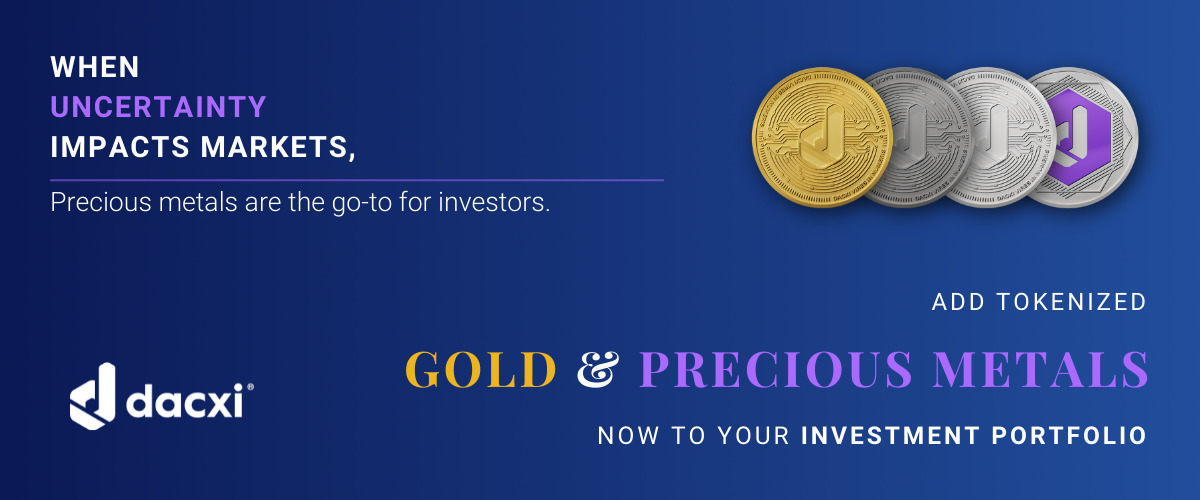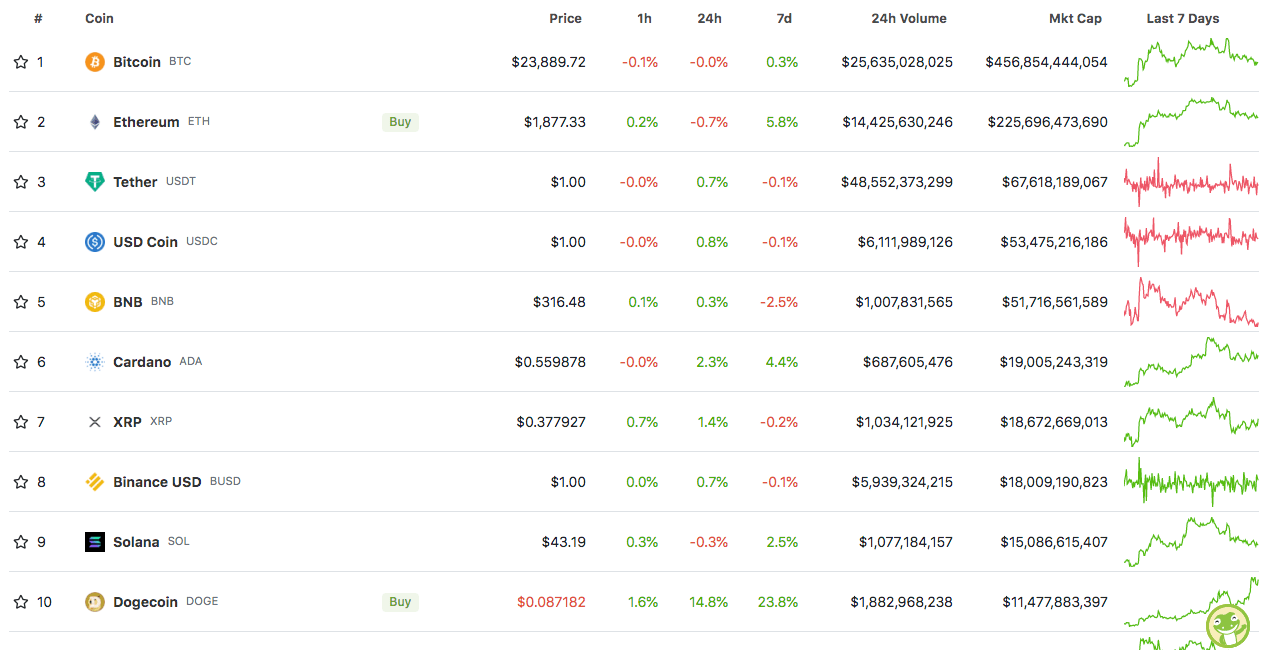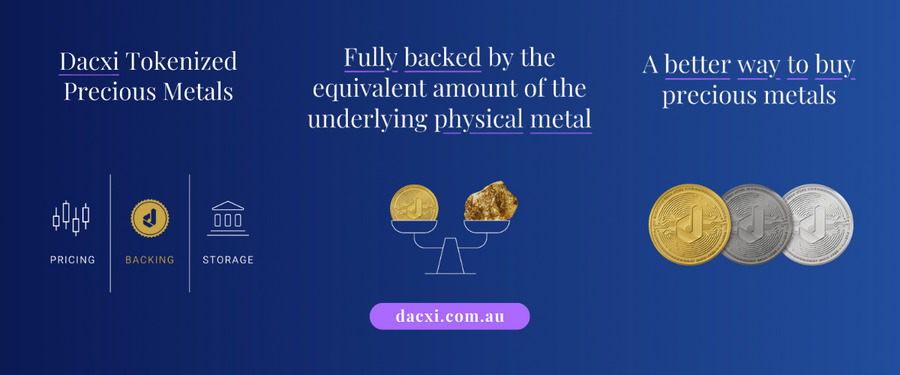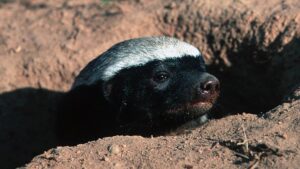Mooners and Shakers: DOGE surges on Dogechain momentum; other crypto majors flatten

Getty Images
Mooners and Shakers is sponsored by Dacxi, the world’s first purpose-built Crypto Wealth platform.

What’s with these dog coins at the moment? After taking a brief nap yesterday, Dogecoin (DOGE) is surging again, which apparently can be attributed to its new layer 2 spinoff, Dogechain.
More on that in a minute, but meanwhile, Bitcoin (BTC), Ethereum (ETH) and most other major cryptos are looking decidedly undecided about their next move, as some more macroeconomic fear gives global traders runny bottoms. And a chunk of that is emanating from China again.
But anyways, on to to some price action…
Top 10 overview
With the overall crypto market cap at US$1.19 trillion and down about 1% since yesterday, here’s the current state of play among top 10 tokens – according to CoinGecko.

Yep, no. 10 crypto and still the top-dog memecoin, Dogecoin is leading the pack for gainz today – in fact, it’s not even a contest. DOGE is up nearly 15% over the past 24-hours, surging to a three-month high and closer to 9 cents on the US dollar.
So, Dogechain… what’s that all about, then? It’s an Ethereum-compatible smart contract network built using Polygon Edge and it’s being marketed as a “layer 2” network for Dogecoin.
Bringing smart-contract capabilities to the Dogecoin community seems like a pretty big deal for Elon Musk’s fave crypto project. It essentially allows users to bridge DOGE onto the Dogechain network in order to access its applications – such as Uniswap-style AMMs (DogeSwap and DogeShrek) and maybe NFT/GameFi offerings in the future, among other protocols.
Very basically, how it operates is, when users successfully move DOGE onto the Ethereum virtual machine (EVM)-compatible chain, they receive a wrapped version of the token called wDOGE, which is a 1:1 representation of DOGE on Dogechain. wDOGE will be usable within the as-yet-developing EVM-friendly network of apps.
Bridging to dogechain, likely going to lose it all. Wish me luck.
— Bagsy (@Bagsy) August 16, 2022
Dogechain apparently went live earlier this month, but has just started to gain traction now, thanks to the power of Twitter influencers like “Bagsy” (219k followers), above and McKenna (42k) below…
https://twitter.com/Crypto_McKenna/status/1559179436578279438?ref_src=twsrc%5Etfw%7Ctwcamp%5Etweetembed%7Ctwterm%5E1559179436578279438%7Ctwgr%5E7d1f175736e415282ee230806c23056a13655b55%7Ctwcon%5Es1_&ref_url=https%3A%2F%2Fwww.kitco.com%2Fnews%2F2022-08-16%2FDogecoin-rallies-higher-as-excitement-builds-for-the-EVM-compatible-Dogechain-network.html
But wait… that’s not all… there’s actually another Dogecoin smart-contract project in development by the Dogecoin Foundation, and that one’s less-snappily called Libdogecoin.
Here’s the foundation’s director, Timothy Stebbing, lauding the power of this DOGE smart-contract exploration, which he believes will bring growth to the network.
Shafil Alam demonstrates the power of libdogecoin to bring #dogecoindev to new realms: having now compiled for iOS & Android (for @FlutterDev). We have @chromatic_x with Perl, @inevitable360 with php, Jaxalotl with Python .. so many ways to build new doge apps brewing! 👀 https://t.co/3kpGx1ZWCD
— Timothy Stebbing (@tjstebbing) August 14, 2022
Confused? Is some sort of dog fight about to play out for the leading DOGE layer 2? Don’t care?
In any case, if you hold DOGE you’re doing okay on the back of it all today, and remember, the top meme coin was one of the best-performing cryptos of the 2021 bull run. Maybe, just maybe a bullish run on these dog coins (SHIB is up 54% over the past week) could be a harbinger for a larger “alt season”.
A grain of salt on that one, of course… Something about dire macro background, recession, Fed, China… yada yada…

Uppers and downers: 11–100
Sweeping a market-cap range of about US$10.1 billion to about US$506 million in the rest of the top 100, let’s find some of the biggest 24-hour gainers and losers at press time. (Stats accurate at time of publishing, based on CoinGecko.com data.)
DAILY PUMPERS
• Dogecoin (DOGE), (mc: US$11.66 billion) +15%
• EOS (EOS), (mc: US$1.39 billion) +9%
• Chiliz (CHZ), (mc: US$1.13 billion) +7%
• Tezos (XTX), (mc: US$1.7 billion) +5%
• Gala (GALA), (mc: US$531 million) +4%
DAILY SLUMPERS
• Celsius (CEL), (mc: US$1 billion) -15%
• Lido DAO (LDO), (mc: US$1.45 billion) -6%
• BitDAO (BIT), (market cap: US$571 million) -4%
• Kava (KAVA), (market cap: US$544 million) -4%
• LEO Token (LEO), (market cap: US$4.88 billion) -4%
Around the blocks
A selection of randomness and pertinence that stuck with us on our morning moves through the Crypto Twitterverse…
#Bitcoin https://t.co/Tf5orGtuJ4
— naiive (@naiivememe) August 16, 2022
The biggest concern for #crypto is the deviation from #stocks since June.$BTC and $SPX were locked together before that.
Things could get ugly for #Bitcoin if the S&P 500 decides to test the 3,400 pre-COVID high, which I think is more than likely. pic.twitter.com/2RDNsG3pS0
— Justin Bennett (@JustinBennettFX) August 16, 2022
Related Topics
UNLOCK INSIGHTS
Discover the untold stories of emerging ASX stocks.
Daily news and expert analysis, it's free to subscribe.
By proceeding, you confirm you understand that we handle personal information in accordance with our Privacy Policy.








